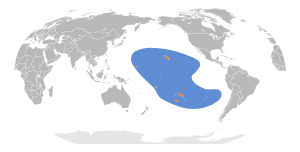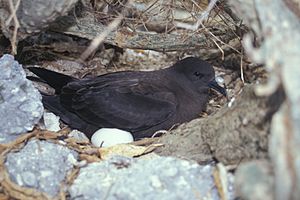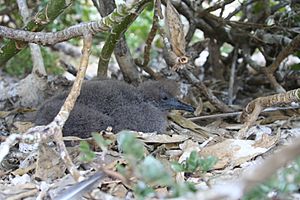Christmas shearwater facts for kids
Quick facts for kids Christmas shearwater |
|
|---|---|
 |
|
| Adult taking off, French Frigate Shoals | |
| Conservation status | |
| Scientific classification | |
| Genus: |
Puffinus
|
| Species: |
nativitatis
|
 |
|
The Christmas shearwater (also called ʻaoʻū) is a medium-sized seabird. Its scientific name is Puffinus nativitatis. This bird lives in the tropical Central Pacific. It's not very well known because it nests in faraway places. Scientists haven't studied it much at sea either.
This shearwater is part of a very old bird family. Its closest living relative is the Galápagos shearwater.
Contents
About the Christmas Shearwater
The Christmas shearwater was first described in 1877 by an American scientist named Thomas Hale Streets. He gave it its scientific name. Scientists have studied its DNA to learn more about its family tree. They found that its closest living relative is the Galápagos shearwater.
What Does It Look Like?
The Christmas shearwater is a slender bird. It is about 36 cm (14 inches) long. Its wings can spread about 75 cm (30 inches) wide. It weighs around 350 g (12 ounces).
This bird is mostly dark. It has blackish-grey feathers with a bit of rusty-brown color. Its belly is slightly lighter. It might have a small bit of white under its chin. Its feet are brown-grey, and its beak and eyes are dark. Male and female birds look the same. Young birds also look like the adults after they learn to fly. Baby birds are covered in dark grey fluffy feathers.
The Christmas shearwater looks a bit like the Sooty shearwater and short-tailed shearwater. But the Christmas shearwater is smaller. It also has dark brown feathers under its wings. Its tail looks pointed when it flies. This is because its feet stick out past its tail. It often flies in a relaxed way, like other birds in its family. This can make it look like a petrel.
Where Do They Live?

Christmas shearwaters nest on remote islands in the Central Pacific. These islands include the Northwestern Hawaiian Islands, Tuamotu, the Marshall Islands, Kiritimati, and Sala-y-Gómez. The bird is named after Kiritimati, which is also known as Christmas Island.
Sadly, they have disappeared from some islands, like Wake Island. When they are not nesting, they fly across the Pacific Ocean. They have been seen near Mexico and Guatemala in the east. They have also been seen near the Bonin Islands in the west. They are rarely seen further south, like near Fiji.
How Do They Behave?
What Do They Eat?

Like other shearwaters, these birds find their food in the ocean. They mainly eat squid and fish. They especially like flying fish and goatfish. They spend most of their lives far out at sea. They often follow bigger fish like tuna. These bigger fish help by chasing smaller prey closer to the surface.
Shearwaters are known for their special way of flying. They glide over the waves with stiff wings, almost "shearing" the water. This is how they got their name. But the Christmas shearwater also uses a more relaxed way of flying. It moves its wings slowly, like a petrel.
How Do They Breed?
Christmas shearwaters build their nests on sandy islands. They like places with good plant cover. They nest on the ground, often under thick plants like naupakas or under rocks.
They lay one white egg. The time they lay eggs can be different on various islands. On some islands, they might breed all year round. The egg stays in the nest for about 50 days before hatching. The time it takes for the young bird to learn to fly also changes with the season. It can take anywhere from 60 to 100 days.
Are They Safe?
Scientists haven't done many specific studies on Christmas shearwaters. However, many seabirds are in danger around the world. Threats include fishing gear, eating plastic waste, and losing their homes.
For example, on Laysan Island, rabbits were brought in by people. These rabbits ate the plants that the shearwaters used for cover. This left the adult birds, chicks, and eggs open to getting too hot. Also, black rats were introduced. These rats ate the eggs and chicks.
In 1985, about 5,000 Christmas shearwaters were counted on Sala-y-Gómez. This island is a nature sanctuary. Because the Christmas shearwater lives in many places and has a good number of birds, it is considered a species of least concern by the IUCN. This means it is not currently in danger of disappearing.
See also
 In Spanish: Fardela de Pascua para niños
In Spanish: Fardela de Pascua para niños


